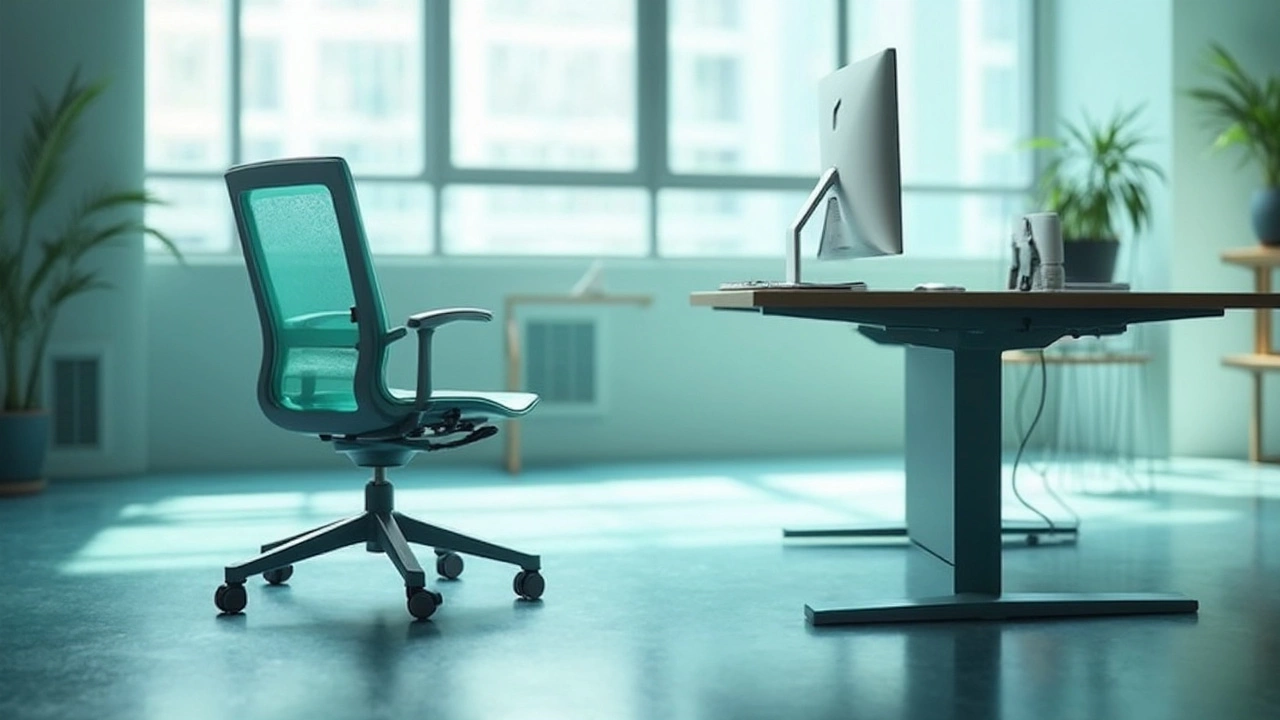Office Chairs: How to Choose Comfort and Boost Productivity
Spending hours at a desk means your chair does more than just hold you up – it shapes how you feel and work. A good office chair can keep your back happy, your focus sharp, and your energy up. A bad one, on the other hand, turns a simple task into a nagging ache. Let’s cut through the jargon and give you straight‑forward steps to pick a chair that actually works for you.
Adjust the Basics First: Height, Depth, and Armrests
The first thing to check is the seat height. Your feet should rest flat on the floor, knees at a 90‑degree angle, and your hips slightly lower than your shoulders. Most chairs have a lever under the seat – pull it, raise or lower, and lock it in place. If you’re sharing a desk with a partner, pick a model with a wide adjustment range.
Next, look at the seat depth. Sit back, press your forearm against the backrest, and make sure there’s about two fingers of space between the edge of the seat and the back of your knees. Too deep and you’ll slide forward; too shallow and you’ll feel pressure under the thighs.
Armrests are a frequent debate. If you need support for your elbows while typing, pick chairs with adjustable arms that move up, down, in‑ and out‑ward. If you prefer a freer range of motion, a chair with removable or low arms works better. The key is that your shoulders stay relaxed and your wrists stay neutral.
Durability and Safety: What to Expect Over Time
How long a chair lasts depends on the frame, base, and how often you sit in it. Steel or reinforced aluminium frames tend to hold up for eight to ten years, while cheaper plastic bases may start creaking after a few years. Check the warranty – a five‑year guarantee on the base is a good sign of confidence.
Safety isn’t just about weight limits. Look for chairs that meet EN 1335 or BIFMA standards – they’ve been tested for stability, tilt, and durability. If you’re eyeing a budget brand like Ikea, read customer reviews for real‑world performance and make sure the chair locks securely when you tilt.
When it’s time to replace, you’ll notice signs: a wobbling base, a sagging seat cushion, or a broken tilt mechanism. Ignoring these issues can lead to bad posture and back pain, so replace before the damage spreads.
Beyond the basics, a few extra tips can make a big difference. Add a breathable mesh back or a padded lumbar cushion if you feel pressure after a few hours. Keep the chair’s casters clean – dust and hair can jam them and make rolling difficult. Finally, give yourself a quick stretch every hour; even the best chair can’t replace movement.
Choosing an office chair doesn’t have to be a headache. Focus on height, depth, and armrest adjustability, verify durability and safety standards, and watch for wear signs. With a chair that fits your body and work style, you’ll notice less strain, more comfort, and a smoother workday. Ready to upgrade? Start testing a few models at a local store, adjust the settings, and pick the one that feels like it was made just for you.
Is It OK to Sit on a Chair All Day? The Real Health Impact and What to Do Instead
Sitting all day harms your back, heart, and mind-even if you exercise after work. Learn how to move smarter, choose the right chair, and break the habit without quitting your job.
Correct Office Chair Posture to Prevent Belly Fat
Learn how the way you sit in an office chair can affect belly fat and get practical tips, adjustments, and micro‑exercises to keep your core active while you work.
Office Chair Armrests: Should You Remove Them for Better Comfort and Ergonomics?
Wondering if you should take the arms off your office chair? Explore how armrests affect comfort, posture, and productivity—and find out what's best for you.
Office Chair Height: The Best Sitting Position for Comfort and Health
Is it healthier to set your office chair higher or lower? Discover how chair height influences your posture, comfort, and productivity, plus practical tips to find your ideal setup.
How Long Should an Office Chair Last? Durability, Lifespan & Real-World Tips
Wondering how long a good office chair should last? Get honest facts and practical tips on durability, value for money, and keeping your favorite seat in shape.
Are Ikea Office Chairs Safe? Real Talk on Comfort and Reliability
Wondering if Ikea office chairs are actually safe for daily work? This article breaks down what safety means when it comes to office chairs, digs into Ikea's safety records, customer feedback, and product testing, and looks at some real-world tips for safer, comfier seating. If you're thinking of buying, you'll get clear pointers about what to look out for and which features actually matter. Let’s settle whether an Ikea chair is really a good bet for your workspace.
How to Flatten Your Stomach While Sitting: Real-World Tricks for Office Chairs
Sitting at a desk can sabotage your efforts to flatten your stomach, but it doesn't have to. This article breaks down practical and doable ways to work on your core while you sit at work—without turning your desk into a gym. You’ll find out which postures, movements, and tiny habits can help you out, plus facts about how your chair plays a sneaky role. Whether you’re at your desk eight hours a day or just stuck in traffic, these tips cut through the noise so you can actually see results. Get ready to rethink what you can do for your abs while you sit.
Office Chairs: To Arm or Not to Arm?
Choosing between an office chair with or without arms can impact your comfort and productivity. Whether you're working from home or at the office, understanding the pros and cons of each option will help you make a more informed decision. This article explains the benefits and drawbacks of both types, along with practical tips to enhance your work environment. Gain insights to align your seating choice with your needs and preferences.
Understanding the Three Supports of ADHD in Office Chairs
Explore how the concept of the 'three legs' of ADHD can be metaphorically applied to enhance office chair design, promoting improved focus and productivity. Delve into ergonomic solutions, creative seating innovations, and how they can support individuals with ADHD in a workspace setting. Learn about practical tips and adjustments that cater to comfort and concentration. Discover facts that simplify office dynamics for everyone. Ideal for those looking to merge creativity with functionality in office environments.
The Most Unhealthy Sitting Position: Avoiding Common Mistakes for Better Health
Sitting incorrectly can have a surprising impact on your health, leading to back pain and fatigue. Discover which sitting position is considered the most unhealthy and learn how to adjust your sitting habits for better posture. Practical tips can help alleviate discomfort while improving your desk setup. Find out how to keep your back in check and maintain a healthier sitting routine.
When to Replace Your Office Chair for Optimal Comfort and Productivity
Your office chair is more than just a piece of furniture; it plays a crucial role in supporting your posture and boosting productivity. Knowing when to replace it can save you discomfort and even health issues. The key factors that determine its lifespan include the quality of materials, usage frequency, and wear and tear signs. Dive in to discover tips on maintaining your chair and guidelines on when it's time to invest in a new one.
Comfortable and Ergonomic Chairs for Long Work Sessions
Finding the right chair for long hours at the desk involves considering ergonomics, adjustability, material, and personal needs. This guide explores the significant features that make a chair comfortable and supportive for extended sitting. We'll dive into staple designs and share insights on how to pick a chair that maintains good posture and alleviates the strain. Armed with these tips, making an informed decision becomes as easy as a good stretch mid-day.


















